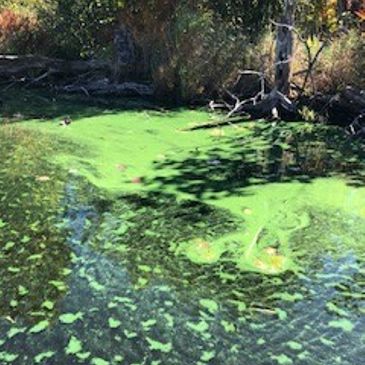Research
We have done considerable research and consulting with Dr. Todd Miller of UW-Milwaukee, Cason and Associates, and John Hinde of Air Diffusion Systems. Nine members of the TLTF have collected six months of water samples for Dr. Miller’s data collection research. Between 60-70% of Tug Lake residents contributed to the funding of Dr. Miller and Cason for their work.
Overview

What Is Blue-Green Algae?
Cyanobacteria, also called "blue-green algae" are relatively simple, primitive life forms closely related to bacteria. Typically much larger than bacteria, they photosynthesize like algae. Depending upon the species, cyanobacteria can occur as single cells, filaments of cells, or colonies. Cyanobacteria contain a characteristic pigment wh
Cyanobacteria, also called "blue-green algae" are relatively simple, primitive life forms closely related to bacteria. Typically much larger than bacteria, they photosynthesize like algae. Depending upon the species, cyanobacteria can occur as single cells, filaments of cells, or colonies. Cyanobacteria contain a characteristic pigment which gives the group their blue-green coloration. When cyanobacteria blooms begin to die and disintegrate, this pigment may color the water a distinctive bluish color. Cyanobacteria are found throughout the world in terrestrial, freshwater and marine habitats, but blooms typically occur in freshwater.

What is a blue-green algae bloom?
Nutrient-rich bodies of water such as some lakes or ponds may support rapid growth of cyanobacteria. With the right conditions, a "clear" body of water can become very turbid with green, blue-green or reddish-brown colored algae within just a few days. High concentrations of an alga species in a water body form "blooms." Many species can
Nutrient-rich bodies of water such as some lakes or ponds may support rapid growth of cyanobacteria. With the right conditions, a "clear" body of water can become very turbid with green, blue-green or reddish-brown colored algae within just a few days. High concentrations of an alga species in a water body form "blooms." Many species can regulate their buoyancy and float to the surface to form a thin "oily" looking film or a blue-green scum several inches thick. The film may be mistaken for a paint spill. Cyanobacteria cannot maintain this abnormally high population for long and will rapidly die and disappear after one to two weeks. If conditions remain favorable, another bloom can quickly replace the previous one. In fact, successive blooms may overlap so that it may appear as if one continuous bloom occurs for up to several months.

Why is blue-green algae a problem?
Blue-green blooms can pose a human health concern. Although most blue-green blooms are not toxic, some blue-green algae produce nerve or liver toxins. Toxicity is hard to predict in part because a single species of algae can have toxic and non-toxic strains. Also a bloom that tests non-toxic one day can turn toxic the next day. People may
Blue-green blooms can pose a human health concern. Although most blue-green blooms are not toxic, some blue-green algae produce nerve or liver toxins. Toxicity is hard to predict in part because a single species of algae can have toxic and non-toxic strains. Also a bloom that tests non-toxic one day can turn toxic the next day. People may become ill after swimming or water skiing in lakes with toxic blue-green algae. Rarely, humans may experience stomach pains, vomiting, diarrhea, and skin rashes. Nerve and liver damage have been observed following long-term exposure such as drinking water with toxic blooms. Pets and wildlife have died after exposure to toxic blue-green algae.

What can we do about blue-green algae?
What can we do about blue-green algae?
The long term solution for controlling blue-green algae involves finding ways to reduce nutrient inputs into the lake. There are best management practices that lake residents and land owners along our watershed can follow. Things such as; maintaining a buffer zone near the shoreline or inlet stream, not fertilizing lawns near the lakesh
The long term solution for controlling blue-green algae involves finding ways to reduce nutrient inputs into the lake. There are best management practices that lake residents and land owners along our watershed can follow. Things such as; maintaining a buffer zone near the shoreline or inlet stream, not fertilizing lawns near the lakeshore or over fertilizing adjacent farm land, ensuring septic systems are working properly, and controlling runoff from adjacent farmlands. These are only a few of the practices we can control. County Land Services and Agricultural representatives are valuable resources for more ideas.

Buoy Data
What can we do about blue-green algae?
CLMN Report
To view the buoy data click on the link below:
https://web.uwm.edu/lakestat/BuoyData/TUG/dash.php
Data updates every 2-10 minutes.

CLMN Report
What can we do about blue-green algae?
CLMN Report
Here is the link to the Tug Lake CLMN report page: WEx WDNR